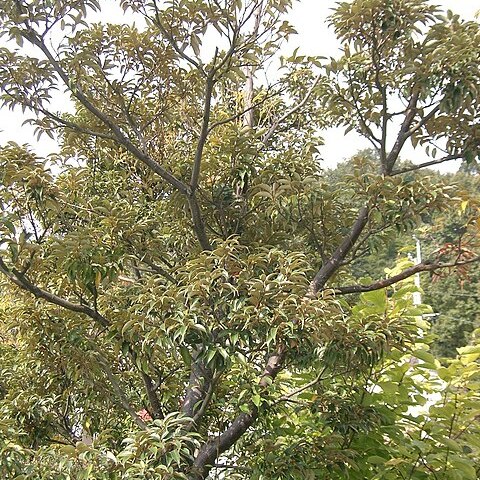Trees of medium to large size. Innovations densely yellowish brown to fulvous pubescent or stellate-hairy. Terminal buds ovoid to ellipsoid, scales ovate to linear. Stipules extrapetiolar, deltoid to linear-acute, caducous. Leaves spirally arranged, rarely with a tendency to distichy, thin-to thick-coriaceous, concolorous to distinctly discolorous, glabrous or beneath hairy or scaly, margin entire or rarely (in non-Malesian species frequently) serrulate in the apical half. Petiole more or less thickened at the base, terete or flat or shallowly furrowed adaxially. Inflorescence erect, male, female, androgynous, or mixed, including bracts and bracteoles densely stellate-pubescent. Male rachis slender to rigid, solitary in the axil of a lower leaf or in dense paniculate clusters on the lateral or subterminal new shoots, mostly simple; ♂ flowers solitary or in clusters of 3-7 along the rachis or in an androgynous inflorescence along the upper part of the rachis; perianth campanulate, (5-)6(-7)-lobed; stamens (10-)12(-15), filaments filiform, glabrous, anthers dorsifixed, reniform, 0.25-0.35 mm long, 2-celled, 4-lobed, lengthwise dehiscent; pistillode rudimentary (usually less developed than in Lithocarpus), more or less rounded-triangular, densely woolly pubescent. Female, androgynous, or mixed inflorescence simple, rigid, solitary in the axil of a higher leaf or on the upper part of the paniculate cluster; ♀ flowers solitary or in clusters of 3-7 along the rachis1, or in an androgynous inflorescence along the basal part of the rachis, perianth campanulate, (5-)6(-7)-lobed; staminodes 10-12, rudimentary; styles 3-5, conical to terete and slender, connate to recurved, densely hairy at the base, stigmas terminal and punctiform. Cupule completely enclosing the 1-7 fruits except for the persistent styles and perianth, at maturity splitting into a regular number of segments (valves) or irregularly, variously spiny or tubercled or with a few undulating ridges, the spines simple or in bundles or stellate, on the 2-4(-8) cupule segments with the sutures in between. Fruit more or less rounded with the adjoining sides flat, wall bony to woody; scar small to almost occupying the entire surface, glabrous, dull, rugose; the remaining part free from the cupule, densely yellowish brown to fulvous tomentellous or glabrous. Cotyledons flat-convex. Germination hypogeal.
More
Trees evergreen. Winter buds ovoid to ellipsoid, with decussate scales. Stipules extrapetiolar. Leaves alternate, distichous, or for a few species spirally arranged. Inflorescences usually unisexual, erect, spicate or paniculate. Male flowers in fascicles of 3-7, rarely solitary and scattered; perianth 5-or 6(-8)-lobed; stamens (8 or)9-12; rudimentary pistil very small, densely covered with curved woolly hairs. Female flowers solitary or in clusters of 3-5(-7) per cupule; staminodes when present opposite perianth lobes; ovary 3-loculed; styles (2 or)3(or 4); stigmas punctiform or shallow terminal pores. Cupules solitary on rachis, actinomorphic or zygomorphic, rarely indehiscent, completely or partially enclosing nut; bracts sparsely to densely covering outside of cupule, spinelike or rarely scalelike or tubercles (cupule measurement always includes bracts). Nuts 1-3 per cupule, maturing after 2nd year or rarely in 1st year; abortive ovule apical. Germination hypogeal; cotyledons slightly convex, rarely cerebriform rugose.
In Malesia the genus occurs from the everwet lowland to the montane forest, between 0-2500 m, mostly between 1000-1500 m, and on various types of soil, except limestone. On the whole Castanop-sis shuns a seasonal climate. For this reason it is absent from Central Java, except in a few local everwst rain-forest complexes (Mts Muria, Ungaran, Telomojo), East Java, and the Lesser Sunda Islands. C buruana is largely a rain-forest species, but has been observed to survive locally in a seasonally dry area in SW. Ceram which is subject to fire. Of the 34 spp. recognized, only 12, viz. C. borneensis, catappaefolia, curtisii, fulva, inermis, johorensis, lucida, malaccensis, motleyana, oligoneura, pedunculata, and wallichii, are apparently confined to lowland forest (below 500 m); the rest occurs both in the lowland and the submontane or montane forests. Most species start flowering during the rainy season, the ripe fruit being developed about six months after tyhe rainy season. In New Guinea, C. acuminatissima sometimes forms an almost pure stand, and occurs commonly as a codominant together with Anisoptera (Dipt.), Lithocarpus or Notho-fagus, between 1000-1500 m.

